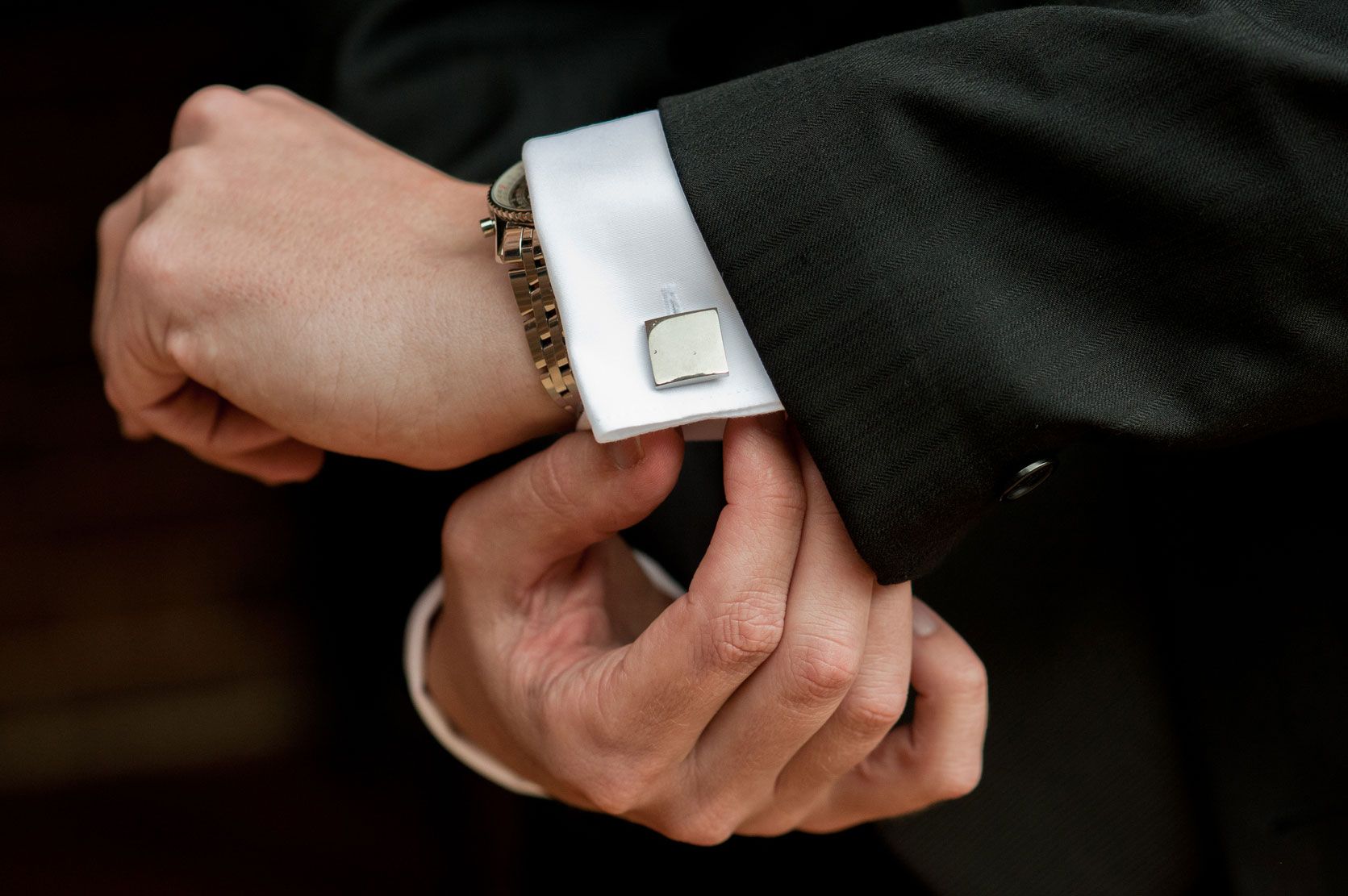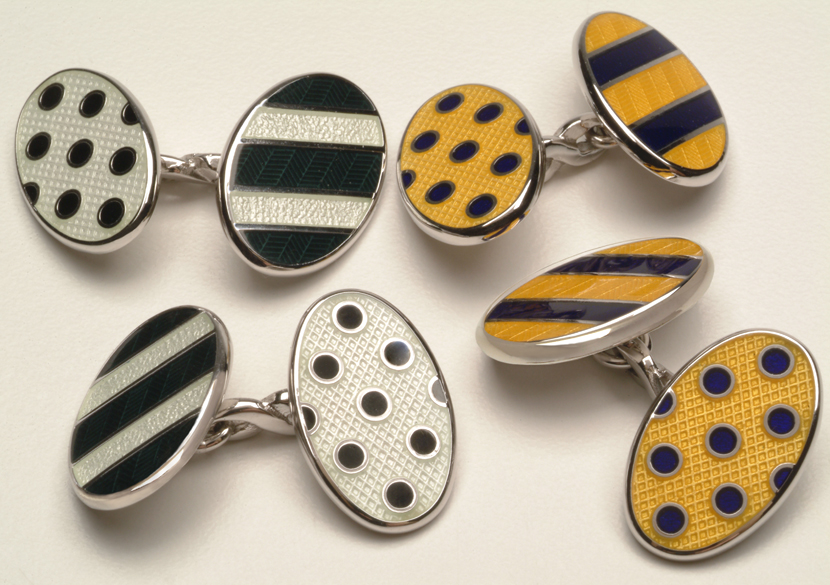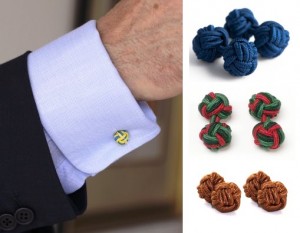
Cufflinks are items of jewelry with a practical purpose; close the cuffs of dress shirts with buttonholes on both sides and no buttons. These may be either single or double-length as with french cuffs and may be worn with the cuffs kissing - with both edges pointing outward - or barrel-style with one edge pointing outward and the other inward so that the hems overlap. Barrel-style cufflinks became popular in the US in the 19th century, being preferred by entertainer and clown Dan Rice. However, “kissing” cuffs are now preferred worldwide.

Although the first cufflinks appeared in the 1600s, they did not become common until the end of the 18th century. Their development is closely related to that of the men's shirt. Men have been wearing shirt-like items of clothing since the invention of woven fabric 5,000 years BC. Although styles and methods of manufacturing changed, the underlying form remained the same: a tunic opened to the front with sleeves and collar. The shirt was worn directly next to the skin, it was washable and thereby protected the outer garments from contact with the body. Conversely, it also protected the skin against the rougher and heavier fabrics of jackets and coats by covering the neck and wrists.

After the Middle Ages, the visible areas of the shirt (neck, chest, and wrists) became sites of decorative elements such as frills, ruffs, and embroidery. The cuffs were held together with ribbons, as collared, an early precursor of neckties. Frills that hung down over the wrist were worn at court and other formal settings until the end of the 18th century, whilst in the everyday shirts of the time, the sleeves ended with a simple ribbon or were secured with a button or a connected pair of buttons.

In the 19th century, the former splendor of the aristocracy was superseded by the bourgeois efficiency of the newly employed classes. From then onward men wore a highly conventional wardrobe: a dark suit by day, a dinner jacket, or tailcoat in the evening. By the middle of the 19th century, modern cufflinks became popular. The shirt front as well as collar and cuffs covering areas of the most wear were made sturdier. This was practical but when clean and starched, collars and cuffs underscored the formal character of the clothing. However, they could be too stiff to secure the cuffs with a simple button. As a consequence, from the mid 19th century onward men in the middle and upper classes wore cufflinks. The industrial revolution meant that these could be mass-produced, making them available in every price category.

Double-Panel Cufflinks
Colored cufflinks made from gemstones were initially only worn by men with a great deal of self-confidence, however. This situation changed when the Prince of Wales, later Edward VII, popularised colorful Fabergé cufflinks in the 19th century. During this time cufflinks became fashion accessories and one of the few acceptable items of jewelry for men in Britain and the U.S.
Fabergé cufflinks


Swiverl Bar Cufflinks
This development continued into the early 1900s, with more cufflinks worn than ever before. These were available in every type of form, color, and material, incorporating both gemstones and less precious stones and glass in cheaper copies. Intricate colored enameled cufflinks in every conceivable geometric pattern were especially popular. All of these were of equal value, as Coco Chanel had made fashion jewelry acceptable to wear. In a parallel development, however, a sportier style of shirt emerged with unstarched cuffs that could be secured with simple buttons.
Closing Mechanisms
Locking the parts of the cufflinks together is achieved in a number of ways. Common ways to secure is reverses or toggles based on the design of the front which can then be folded into position. There are also variants with a rigid bent rear section or ones with chains. The front sections are usually decorated with inset materials, enamel, inlays, gemstones, or the cloth of the necktie or bow tie so that they match. The can be designed in two or three dimensional forms.

3-dimensional novelty cufflinks
Closing Mechanisms are not limited to the most traditional “double-panel” which consists of 2 disc-shaped parts, both decorated. Whale-back and toggle back cufflinks have a flat decorated face for the side facing out and are easily visible. The other side shows only the swivel bar and its post. The swivel bar is placed vertically aligned with the post to put the links on and off, and then turned horizontally to lock them in place when worn. The decorated face is usually larger and is connected to the smaller piece by a variety of designs. The smaller piece has to be small enough to fit through the buttonhole. It may be separated and attached from the other side; or it may have a portion that swivels on the central post, aligning with the post while the link is threaded through the button-hole and swiveling into a position at right angles to the post when worn. Links of knotted brightly colored silk enjoyed renewed popularity in the 1990s, joined by an elasticated section.
Interchangeable Cufflinks
Interchangeable cufflinks have started to come back into the marketplace in recent years. Cartier introduced their type in the 1960s consisting of a bar with a loop at either end that would allow a motif to be inserted at either end perpendicular to the bar. Cartier referred to the interchangeable motifs as batons. A set including the bars would come with batons made from gemstones like coral, carnelian, lapis lazuli, rock crystal, onyx, tiger's eye, and malachite. Bars would have been made from stainless steel, sterling silver or 18k gold.
Cartier recently re-introduced these interchangeable cufflinks with batons made from striped chalcedony, silver obsidian, malachite, sodalite, and red tiger's eye. The accompanying bars are made from 18k gold or palladium-plated sterling silver. The securing mechanism is the same for either series using a small screw inset into the looped end of the bar. The pressure exerted a by the screw on the baton holds them in place.
Another type of interchangeable system was created by Pranga & Co. The patent-pending cufflink system comes apart allowing the motif, referred to as an Anker, to slide on. Putting the cufflink back together secures the anker into the cufflink allowing it to be worn. Pranga & Co's cufflink is simple and similar in concept to charm bracelet bead systems popularized by companies like Pandora Jewelry. The ankers used in the cufflinks are interchangeable with various charm bracelets systems and visa-versa.
Fabric Cufflinks
An alternative type of cufflink is the silk knot which is usually two conjoined monkey's fist or Turk's head knots, and is much chepaer. The Paris shirtmaker Charvet is credited with its introduction in 1904. They became quickly popular in 1908. French cuff shirts are often accompanied with a set of color-coordinated silk knots instead of double-button cufflinks. They are now often not from silk and consist of fabric over an elasticated core. Owing to the popularity of this fashion, metal cufflinks shaped to look like silk knot are also worn.

The Fremch Cuff is fastened with silk knots.
Motif
The motifs are however not limited to precious stones or metals. Cufflinks can be made from glass, enamel, leather, gemstones, non-precious and precious metals, even elastic rubber, or a combination of these. The visible part of a cufflink is often monogrammed or decorated in some way, such as with a birthstone or something which reflects a hobby or association. There are numerous styles including novelty, traditional, or contemporary. Cufflinks can and have been worn with casual wear, informal attire or business suits, all the way to very dressy styles such as semi-formal (black tie), and formal wear (morning dress or white tie), where they become essentially required and are matched with shirt studs. Colorful and whimsical cufflink designs are usually only suitable for casual and relatively informal events and signal someone who is fun-loving, approachable, and friendly. However, formal wear has stricter expectations, with pearl cufflinks being preferred for white tie events. Traditionally it was considered important to coordinate the metal of one's cufflinks with other jewelry such as watch case, clutch bag, belt buckle, tie bar or rings. Sartorial experts prescribe gold to be worn during the daytime and silver for evening wear, but neither expectation is considered as critical as it once was.


Comments (0)
Back to Blogs